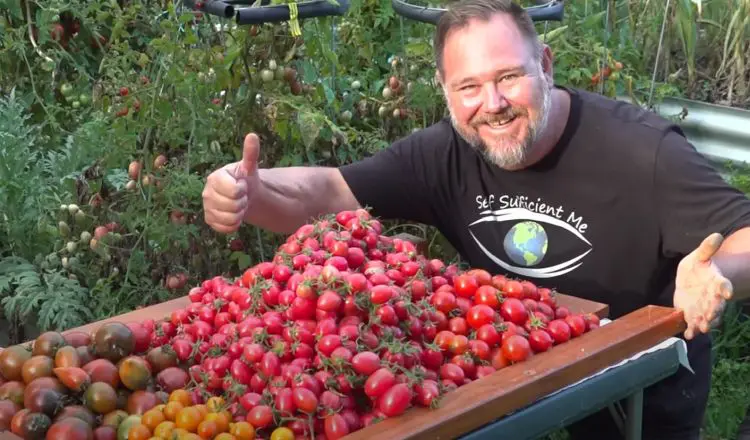Tomatoes are at the top of every vegetable gardeners’ must-grow list. And while the plant itself grows easily enough, producing large, tasty fruit can be deceptively tricky. Here, we explain 5 ways to make your home-grown tomatoes taste better.

Keep Them Out of The Fridge
Cold is the mortal enemy of tomatoes. This is something that obsessive tomato growers have believed for some time, and it has recently been proven by the University of Florida that cold storage destroys both the taste and texture of tomatoes.
Tomato researchers identified that there is a gene associated with flavour which is damaged irreversibly when tomatoes are chilled. This renders them less flavourful than the same tomatoes which have been kept at room temperature. The skin and flesh of the tomatoes also become damaged by the cold, which has a negative effect on the texture, making the skin tougher and the flesh floury. ‘Flouriness’ occurs because the cold breaks down the cell structure of the pulp, resulting in an unpleasant mouthfeel for the consumer.

Because the changes caused by cold storage are permanent, once tomatoes have been refrigerated, their flavour and texture cannot revert to their best. Even if removed from the fridge and left at room temperature, their quality will not return to that when it was first picked.
Tomatoes have a strong natural immunity to most fungi. Sadly, cold storage breaks down their immune system, which allows mould to grow. Grey/black, spidery mould growth on old tomatoes is normal, but this is strongly accelerated by cold storage- see our photo below. Condensation, too, indicates cold storage, and can often be seen on the tomatoes on supermarket shelves.

Sauces containing tomatoes are a different question to fresh tomatoes. We keep our sauces out of the fridge and have never had a problem with mould or deterioration. On a practical level, I also feel like room temperature sauces are less viscous and therefore easier to serve. Others choose to refrigerate their sauces, believing that it stops them ‘going off’ and keeps any fermentation flies away. Whichever you choose, I doubt it affects the flavour of a sauce- just don’t put fresh tomatoes in the fridge.
Pick Tomatoes at the Right Time- Not Too Early
Animals, like humans, love tomatoes. So the temptation (or necessity!) to pick tomatoes early is a big one. Unfortunately, picking them while still green or with the colour only just turning is a bit too early because it reduces the overall flavour. This happens because some of the sugars and hormones that create flavour only do so in the later stages of fruit development. No matter what their final colour or size, picking tomatoes when they are fully ripe is always best.
If you do need to pick your tomatoes a bit early, make sure they at least have a good blush of colour on them. This way, the tomato should be fine, as it will have enough sugars by this stage to develop adequate flavour. The exceptions to this of course are the varieties which stay green, which won’t turn red no matter how long you wait.

Don’t Buy Ethane Gas-Ripened Tomatoes
People who buy the cheapest, generic supermarket tomatoes are really missing out- but that’s probably not news to you. Tomatoes contain a critical hormone called ethylene, which regulates the ripening and helps give tomatoes their great flavour. Many commercial tomatoes are bred to contain less ethylene, or they are ripened artificially with the aid of ethane gas. This allows commercial tomatoes to ripen at the same time, remain firm, withstand transportation over long distances without spoiling, and still look good on supermarket shelves. This lack of ethylene is why commercially-produced tomatoes taste like damp kitchen paper (well I think so, anyway).
Uniform ripening, or ripening all the fruit on one plant at the same time, also contributes to poor flavour. Commercial varieties have this trait bred into them. These plants have been designed to grow a ton of fruit which develops all at once, because it makes for easier machine harvesting.

But this uniform ripening also has a secondary meaning- and that is, having each individual fruit ripening so that its colour is completely uniform. While older heirloom varieties often have a tinge of green on the top or shoulders of each fruit when they are fully ripe, modern supermarket varieties don’t. Uniform colour came about when a 1930s farmer noticed an accidental genetic mutation in his crop. Once plant breeders got hold of it, this uniformity of colour became dominant in commercial farming and has remained so.
Despite mainstream consumers being accustomed to having every inch of their tomatoes the same colour, we have since learned that the green patches on heirlooms play an important role in flavour. Those green spots denote a particular gene that comes from the chlorophyll in the plant, and is responsible for converting sunlight into sugars, which in turn makes the fruit sweeter.
Beware of Bland Varieties
I tend to think and proclaim that my home-grown tomatoes tastes so much better than any you can buy. While this is generally true, I must admit that I’ve grown my fair share of bland tomatoes too.

With over 20 000 varieties of tomatoes floating around the world, it’s no surprise that some simply taste better than others. In my experience, it tends to be the larger-sized tomatoes with good disease resistance that are easier to grow but lack taste.
For overall better taste and ease of growing, I usually focus my efforts on cherry tomatoes. They are reliable, prolific, and the orange-skinned types are QLD fruit-fly resistant, which makes them a breeze to grow and harvest from all through the hot & humid subtropical QLD summer. Having said that, there is nothing better than a truly sensational heirloom beefsteak grown in the right conditions- the taste simply cannot be beaten, and leaves supermarket hybrids far behind.

Keep Up the Nutrition
In the home garden, tomatoes grow best in rich, nutrient-dense soil. The soil needs to include a wide variety of micronutrients and minerals, so adding things like compost, a little bit of crushed rock, manures, trace elements and organic fertilisers is vital.
It’s also important to fertilise throughout the growing season, not just at the beginning. Having the right balance of nutrients (and water!) in the soil at the time of fruiting is especially critical when it comes to tomatoes. This is because fruit development draws a lot of energy from the plant, and tomatoes, as a solanaceae, require consistency of watering to produce at their best. Under-watering tomatoes will result in stressed plants and small fruit. Over-watering them will lead to fruit with split skins that taste bland.
For more info & a visual demonstration of the 5 ways to make your tomatoes taste better, check out our youtube video!













